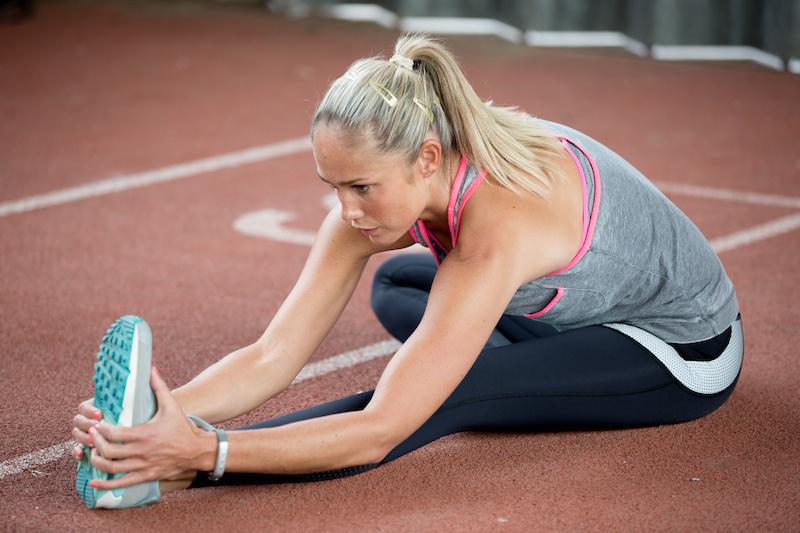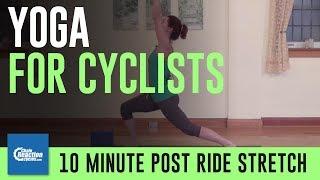
This Postride Yoga Flow Stretches Out All Your Tight Spots
If you love to ride, but don’t love the aches often associated with sitting in the saddle for so long, we have the ideal solution: a postride yoga flow.
Yoga, in general, has some pretty amazing benefits. One study on thetherapeutic effects of yoga, published in the International Journal of Yoga in 2011, found that yoga can enhance strength and flexibility, improve respiratory and cardio function, and promote recovery from chronic pain. Researchers also found evidence that a regularyogapractice offers protection against conditions like osteoporosis, arthritis, and back pain.
For those riders with lower back pain, a scientific review conducted by researchers at the University of Maryland School of Medicine and published in the Cochran Library in 2017 found that yoga can help improve aches in this area, when compared to non-exercise intervention. (Researchers do note, however, that we need more studies on yoga’s longterm effects on back pain.)
Considering cyclists’ common complaints about aches and pains, a yoga flow could offer a solid antidote to discomfort.
Related StoryAnother Reason to Practice Yoga on Your Rest DaysWhat are the benefits of a postride yoga flow?
“Yoga offers several benefits for cyclists beyond potentially helping to alleviate back pain. It can also offer an option for activerecovery, improve breathing efficiency, lower tension, and help your body move in new ways,” says Brian Beutel P.T., D.P.T., founder of Forge Physio of the Restoration Space in Bethlehem, Pennsylvania.
“Being in a flexed or arched position for long periods of time can be incredibly challenging for many and is something that has to be built up gradually over time,” Beutel says. “Sometimes a cyclist won’t know there is a problem until after there is alreadypain.”
The good news, though, according to Beutel: You can ease that pain with the right exercise prescription. “Training for cycling, like training for any sport, should include a balance between the positive stresses of the sport itself with supportive stresses, like yoga or cross-training.” This helps your body gradually adapt to the sport, recovery properly, and get better over time.
Beutel reminds cyclists that muscles are more adaptable to stress if they’re worked in different ways and continually doing yoga can help with that. “We want longer, strongermusclesand joints that are ‘ready’ for all that they need to accomplish. Taking yoga into consideration, we are combining the length of tissues (which feels like a nice stretch) but also gaining the ability to sustain those positions,” he says.
Also, a postridestretchmakes for a great time to check in with your body and take note of how everything is feeling. “Reflection on the training that just occurred can pay off big and can work inside the cooldown process,” Beutel adds.
How often should you be getting on the mat?
Yoga should complement your cycling, Beutel says. Even just 15 to 20 minutes can offer benefits, but aim for about four to five days a week. The more often you practice, the more benefits you'll reap.
Related StoryA Yoga-Inspired Mobility Workout for Better RidingYoga Poses to Do After a Ride
How to use this list: Follow this yoga flow anytime after a ride. Curated and demonstrated in the video above by Melanie Smith, 500-hour certified yoga instructor, based in Bethlehem, Pennsylvania, this sequence only takes about 10 minutes. Mimic her form and feel relaxed, stretched, and ready for the rest of the day when you’re done.

Why it works: The best way to start a yoga flow, the cat/cow sequence offers a gentle stretch of the spine and neck and also gently begins to open the chest.
How to do it: Start on all fours, with feet and hands shoulder-width apart, hands directly under shoulders and knees directly under hips. Inhale and gaze forward, arching the spine and dropping the belly toward the ground (cow position). Then exhale to bring head down, and round spine, pulling belly up toward ceiling (cat position). As you alternate between the two postures, check in with your body and focus on your breath. Repeat the sequence for 8 breaths.
Why it works: A hybrid of child’s pose and downward-facing dog, puppy press gently stretches your spine and opens your chest.
How to do it: Start on all fours, with hands directly under shoulders and knees directly under hips. Walk hands forward a few inches and curl toes under. As you exhale, move sit bones back toward heels. Keep arms engaged and elbows off the mat. Bring forehead to the floor and allow neck to relax, keeping a slight curve in the lower back. To feel a nice stretch in the spine, press hands down and reach the arms forward, while pulling hips back toward heels. Breathe into your back, noticing the spine lengthening in both directions. Hold for 4 to 6 breaths.
Why it works: Downward-facing dog is a great pose to rejuvenate your entire body, as it helps to reduce tightness in the shoulders, legs, and heels.
How to do it: Start on all fours, hands and feet shoulder-width apart, with hands directly under shoulders and knees directly under hips. Spread fingers apart and grip the mat. Lift hips up and back, allowing a gentle bend in knees as chest comes between shoulders. Press heels toward the floor (though they don’t have to touch the floor). Pedal the feet to relieve any tightness in the back of the legs. Make sure you evenly distribute weight between both feet and hands. If hamstrings are tight, keep a bend in knees. Engage your core and focus on the sound of deep inhales and exhales. Hold for 4 to 6 breaths.
Related StoryBest Yoga Apps for BeginnersWhy it works: Low lunge is a great recovery pose postride, as it opens your chest and provides a nice stretch to the hip flexors.
How to do it: From downward-facing dog, exhale and step right foot forward, between hands, aligning knee over the ankle. Lower back leg to the floor (toes tucked or untucked). As you inhale, lift the torso up and at the same time lift arms up and over head, palms facing each other. Lengthen tailbone toward the floor, and relax the shoulders away from ears as you reach up through the fingertips. Think about drawing the rib cage downward. Hold for 4 to 6 breaths.
Why it works: Crescent lunge stretches your legs, hip flexors, chest, and shoulders—which will feel great after folding forward on the bike. Focus on keeping your leg muscles engaged.
How to do it: From low lunge with right foot forward, left knee on the floor, tuck left toes under. On an inhale float back left knee off the floor, as you press front right foot into the mat. Keep arms arms overhead, biceps by with ears. Relax the shoulders away from ears as you reach up through the fingertips. Imagine tailbone elongating as arms reach up and back foot presses down. Hold for 4 to 6 breaths.
Why it works: Half split is a great low-back and hamstring stretch. You’ll feel it in the hips too.
How to do it: From crescent lunge with right foot forward and back left knee on the ground, shift hips back and straighten front leg, lifting toes. Keeping sending hips back and straightening leg until you feel a gentle stretch. (The leg does not have to be completely straight; you want a slight bend.) Press heel into the floor. Place hands directly under shoulders, either on the mat or blocks. To deepen the stretch, walk the hands toward the feet, framing leg and foot, without rounding back. Hold for 4 to 6 breaths. To come out, walk the hands back and lift the torso.
Return to downward-facing dog and repeat low lunge to crescent lunge to half split on the opposite side, left foot forward.
Related StoryOnline Yoga Classes You Can Do At HomeWhy it works: Your shoulders definitely need a chance to relax postride. Thread the needle is a gentle twist that will relieve all the tension in the upper body.
How to do it: Start on all fours, hands and feet shoulder-width apart, with hands directly under shoulders and knees directly under hips. On an inhale, reach right arm up and then on an exhale, slide right arm underneath left arm with palm facing up. Allow the right shoulder to come all the way down to the mat. Rest right ear and cheek on the mat and gaze toward the left hand. Keep left elbow pointing toward the ceiling as you press into the hands to help stabilize through the chest. Walk left hand forward if that feels good for you. Make sure hips stack over knees. (If you feel pressure in the neck, lean forward and readjust the head.) Allow the upper back to broaden by gently pressing fingertips into the mat. Draw the lower belly in and up, activating abdominals. Hold for 5 to 7 breaths softening any tension around the shoulders and neck. To come out, press through your left hand and gently slide your right hand out. Return to all fours and repeat on the other side.
Why it works: Child’s pose is the perfect pose to calm your body and mind. It offers a gentle stretch of the hips, thighs, back, and ankles.
How to do it: Start on all fours, hands and feet hip-width apart, with hands directly under shoulders and knees directly under hips. Release the tops of feet flat to the floor and bring knees wider than hips (big toes touching). Slowly press back to lower hips toward heels while walking hands forward. Open palms and rest forehead on the mat. Hold for 4 to 6 breaths, or until you feel ready to come out.
Why it works: Corpse pose relaxes the entire body and mind, and can be a great chance to connect with how your body is feeling postride.
How to do it: Lie faceup, arms at sides, palms open. Think of corpse pose as a chance to gradually relax your body—one part at a time. Work your way through the body acknowledging and noting any tight or sore spots in neck, shoulders, arms, fingertips, back, legs, and finally feet. Consciously breathe into those sore areas and feel muscles soften. Rest here for as long as you can.
}})